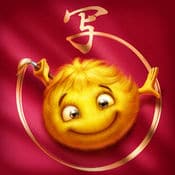
Practice means writing characters to the point where you don’t have to think about how they’re written. As professor Victor Mair of the University of Pennsylvania says, “Writing Chinese characters is a highly neuro-muscular act. You have to etch the characters into your nerves and muscles.”
However, you have to admit that they do make the practice sheets visually appealing.
Filled with a thousand of the most commonly written characters (plus 500 recommended characters) in simplified Chinese, the book uses a tried-and-true approach based on logical ordering, where each character serves as the building block for the next. It’s essentially a memory trick for students that offers background information as they attempt the more difficult characters.
As a beginner or even an intermediate Mandarin Chinese learner, probably not.
Study the evolution of characters
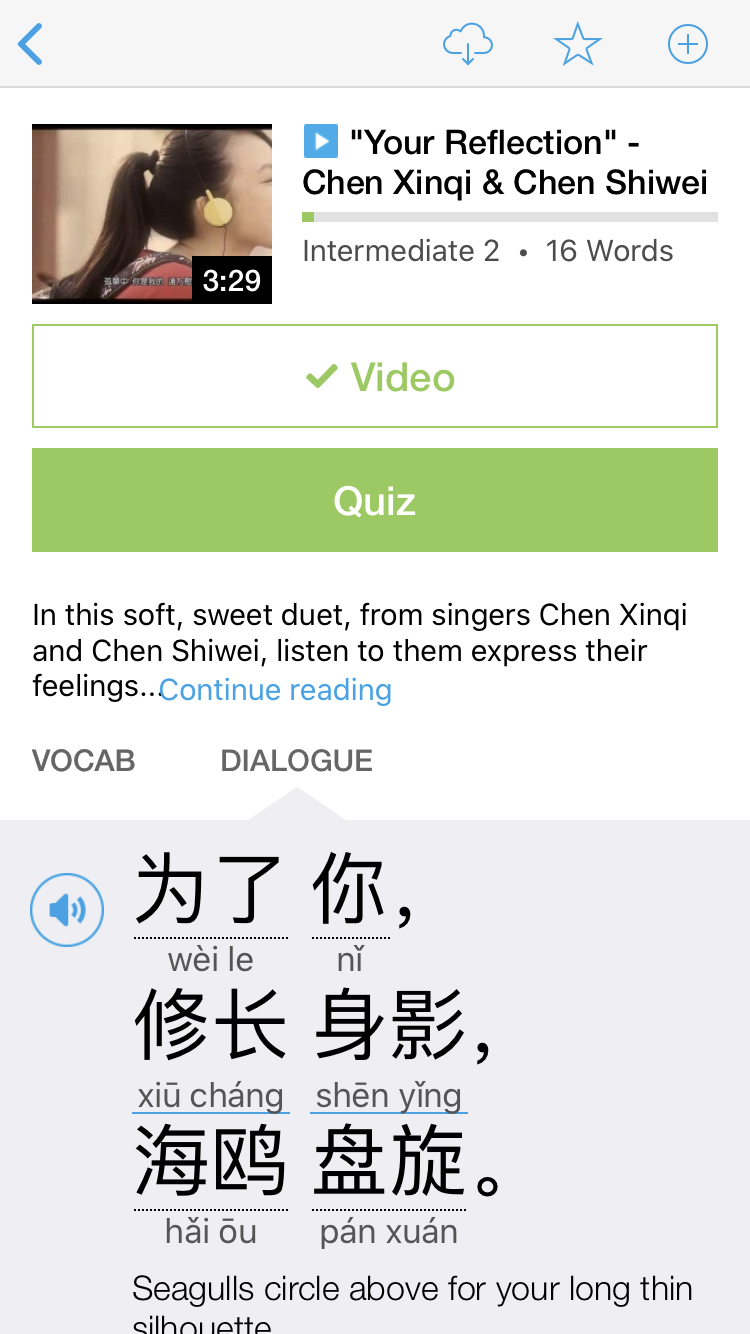
By learning these, you’ll get clues about what other characters mean.
It’s true that many have survived day-to-day life without needing to further their Chinese writing skills. However, if you really want to master the language, writing practice is a must.
Hanzi Grids is a great online program that lets you customize every part of your typical character sheet, from the font of your chosen characters (either simplified or traditional) to spacing and guidelines. You can also add a header to label each sheet and change the color of the grids.
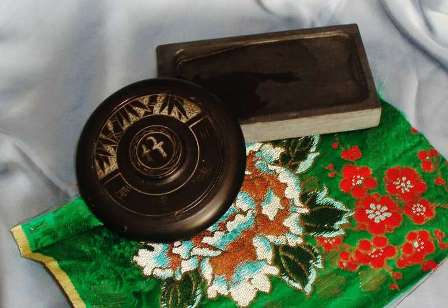
By itself, the ink stone of the calligraphy is very precious art object. But you do not need to pay a fortune to buy a good quality. However, it is preferable that it be fitted with a lid to prevent the ink from drying.
After each practice, the ink stone should be properly washed with running water only. We must also leave a little water in the reservoir to preserve moisture in the stone.
- The absorbent paper(Shengxuan), is the most commonly used.
- The non-absorbent paper: Shu Xuan, also known as Fan Xuan is much less used.
This ink stick is rubbed on an ink stone with a little water. The more you rub the more thick the ink becomes. Then we can also add more water to obtain the various shades of density found in calligraphy.
Hot pages :

The Chinese calligraphy uses a huge variety of brushes. Contrary to what some may think, the choice depends not on a style of calligraphy that we want to practice, but on the frame of mind of the calligrapher: taste, strength, flexibility or stiffness in the wrist and arm, and so on.
Here are the three most commonly used models already presented in the Material of the Chinese painting:
Before using the brush, it should a little be wet before soaking it with ink. Then slightly taps the brush on the inkpot or the saucers to remove the surplus. You should not charge or empty the brush by turning it: it would deform the end.
Free Chinese courses online, origami, Chinese medicine, painting and Chinese calligraphy.

By itself, the ink stone of the calligraphy is very precious art object. But you do not need to pay a fortune to buy a good quality. However, it is preferable that it be fitted with a lid to prevent the ink from drying.
After each practice, the ink stone should be properly washed with running water only. We must also leave a little water in the reservoir to preserve moisture in the stone.
- The absorbent paper(Shengxuan), is the most commonly used.
- The non-absorbent paper: Shu Xuan, also known as Fan Xuan is much less used.
This ink stick is rubbed on an ink stone with a little water. The more you rub the more thick the ink becomes. Then we can also add more water to obtain the various shades of density found in calligraphy.
Hot pages :

The Chinese calligraphy uses a huge variety of brushes. Contrary to what some may think, the choice depends not on a style of calligraphy that we want to practice, but on the frame of mind of the calligrapher: taste, strength, flexibility or stiffness in the wrist and arm, and so on.
Here are the three most commonly used models already presented in the Material of the Chinese painting:
Before using the brush, it should a little be wet before soaking it with ink. Then slightly taps the brush on the inkpot or the saucers to remove the surplus. You should not charge or empty the brush by turning it: it would deform the end.
Free Chinese courses online, origami, Chinese medicine, painting and Chinese calligraphy.
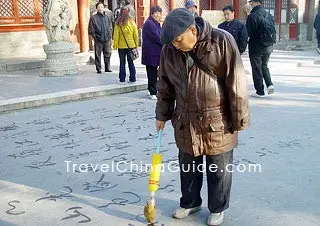
The delicacy gives literators and painters inspiration for creation, and has led to brush shafts being decorated with artistic patterns. One prized example was an ivory-weasel's hair writing brush. On the ivory shaft with the diameter of 0.8 cm, there carved eight figures of the immortals and pavilions concealed seemingly in the clouds. With this in one's hand, the threads of writing would hardly halt.
Calligraphy has endured for more than 2,000 years, and evolved into five main ways of writing each with different techniques. Even today, these are still followed and practiced often as a hobby.
Ancient people paid great attention to calligraphy. It was the essential whereby a candidate could manifest his literary talent in the Imperial Examination, for it gave a first impression to the examiners. Children of high officials had to learn and try to write a good hand
In the Eastern Han Dynasty (25 - 220), people tended to simplify the seal character which had many strokes and created the official script. The new calligraphy appeared to be much neater and delicate, turning the round style into a flat one. When beginning to write a horizontal line, one must let the brush go against the direction of point like a silkworm, and concentrate on stretching steadily, then end up with warp like a swallow's tail. This is one of the characteristics – 'silkworm's head and swallow's tail'.
Ink Stick
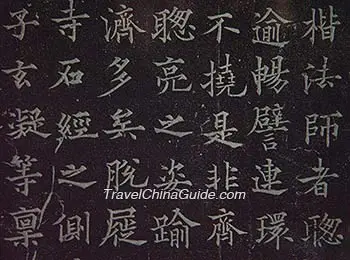
Today, although various modern ways have been substituted for the original calligraphy, especially which created with a writing brush, people still love the ancient form and practise it untiringly. During the traditional festivals, propitious couplets are always indispensable decorations each written in a beautiful style.
To practise calligraphy requires the basic tools of 'four treasures of study' (writing brush, ink stick, paper, and ink slab) as well as much concentration on guiding the soft writing brush charged with fluid ink, and writing on the paper where the ink will diffuse quickly. Once the brush movement hesitates, a black mark is created, so speed, strength and agility is the essence of fine artwork. When writing, many calligraphers will forget all worries and even themselves, combining all thoughts in the beauty of their art. Thus it can be compared with Qigong, which also can mould and improve a person's temper and promote well being.
Cursive script has more flexibility, for it only maintains the essence of each character and expresses more personal exertion. Therefore its value lies in appreciation more than practicality. While the running hand makes full use of connecting lines between two strokes it can be regarded as the quickly-written form of regular script. These two seem to be more unrestrained than the previous styles.
Just as the name implies, the regular script features its regularity and varies from the flat font to a square one. In Chinese it provides a model that can be followed by calligraphy lovers. It has developed since the late Han Dynasty and is today's most popular and influential writing style. The Sage of Calligraphy, Wang Xizhi led the art of calligraphy to its summit. It is recorded that when a carpenter was asked to engrave the wooden stele where there were characters written by Wang Xizhi, he found the ink had filtered into the wood piece 'three fen' deep (3.3cm or 1.3 inch)! This demonstrated the magnitude of his force and people admired him all the more because of it. The period when regular script thrived most was during the Tang Dynasty (618 – 907), when Yan Zhenqing and Liu Gongquan successively established schools of their own styles noted for their strength and mellowness.

The delicacy gives literators and painters inspiration for creation, and has led to brush shafts being decorated with artistic patterns. One prized example was an ivory-weasel's hair writing brush. On the ivory shaft with the diameter of 0.8 cm, there carved eight figures of the immortals and pavilions concealed seemingly in the clouds. With this in one's hand, the threads of writing would hardly halt.
Calligraphy has endured for more than 2,000 years, and evolved into five main ways of writing each with different techniques. Even today, these are still followed and practiced often as a hobby.
Ancient people paid great attention to calligraphy. It was the essential whereby a candidate could manifest his literary talent in the Imperial Examination, for it gave a first impression to the examiners. Children of high officials had to learn and try to write a good hand
In the Eastern Han Dynasty (25 - 220), people tended to simplify the seal character which had many strokes and created the official script. The new calligraphy appeared to be much neater and delicate, turning the round style into a flat one. When beginning to write a horizontal line, one must let the brush go against the direction of point like a silkworm, and concentrate on stretching steadily, then end up with warp like a swallow's tail. This is one of the characteristics – 'silkworm's head and swallow's tail'.
Ink Stick

Today, although various modern ways have been substituted for the original calligraphy, especially which created with a writing brush, people still love the ancient form and practise it untiringly. During the traditional festivals, propitious couplets are always indispensable decorations each written in a beautiful style.
To practise calligraphy requires the basic tools of 'four treasures of study' (writing brush, ink stick, paper, and ink slab) as well as much concentration on guiding the soft writing brush charged with fluid ink, and writing on the paper where the ink will diffuse quickly. Once the brush movement hesitates, a black mark is created, so speed, strength and agility is the essence of fine artwork. When writing, many calligraphers will forget all worries and even themselves, combining all thoughts in the beauty of their art. Thus it can be compared with Qigong, which also can mould and improve a person's temper and promote well being.
Cursive script has more flexibility, for it only maintains the essence of each character and expresses more personal exertion. Therefore its value lies in appreciation more than practicality. While the running hand makes full use of connecting lines between two strokes it can be regarded as the quickly-written form of regular script. These two seem to be more unrestrained than the previous styles.
Just as the name implies, the regular script features its regularity and varies from the flat font to a square one. In Chinese it provides a model that can be followed by calligraphy lovers. It has developed since the late Han Dynasty and is today's most popular and influential writing style. The Sage of Calligraphy, Wang Xizhi led the art of calligraphy to its summit. It is recorded that when a carpenter was asked to engrave the wooden stele where there were characters written by Wang Xizhi, he found the ink had filtered into the wood piece 'three fen' deep (3.3cm or 1.3 inch)! This demonstrated the magnitude of his force and people admired him all the more because of it. The period when regular script thrived most was during the Tang Dynasty (618 – 907), when Yan Zhenqing and Liu Gongquan successively established schools of their own styles noted for their strength and mellowness.
